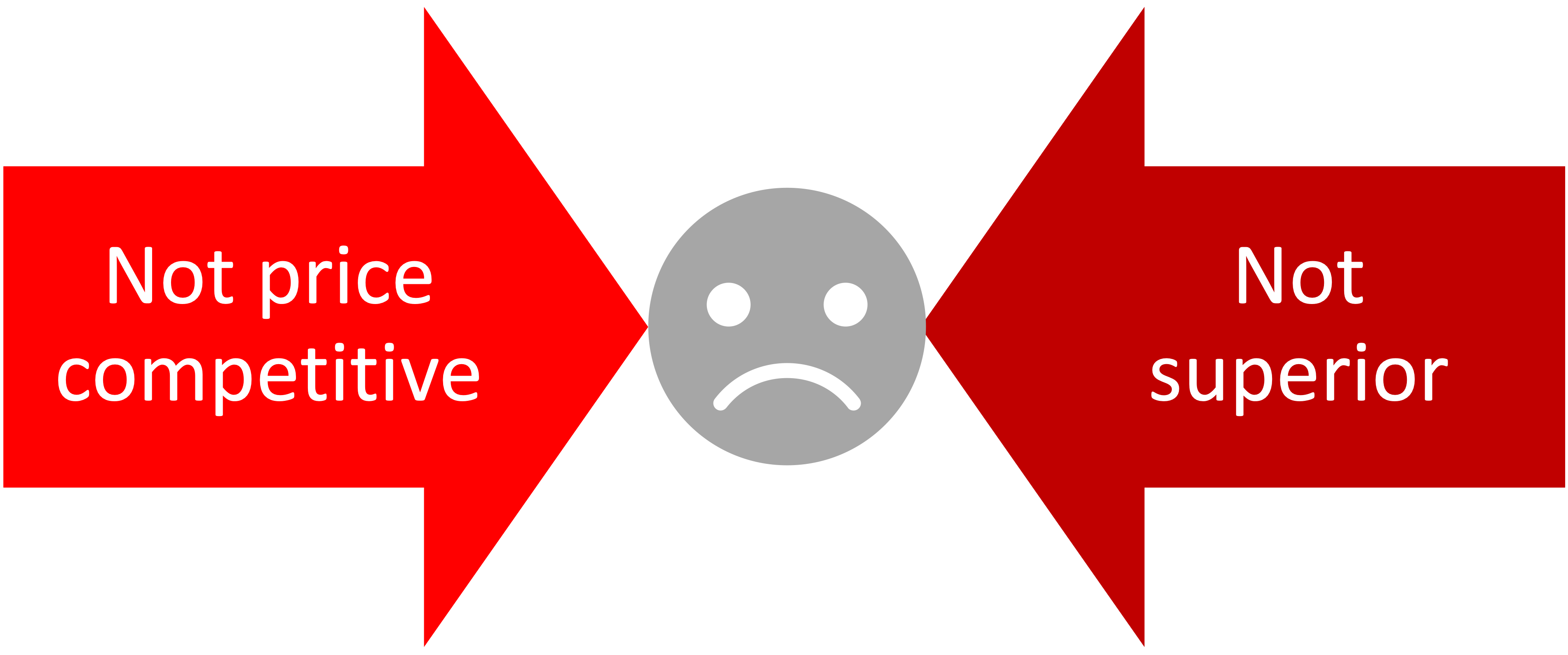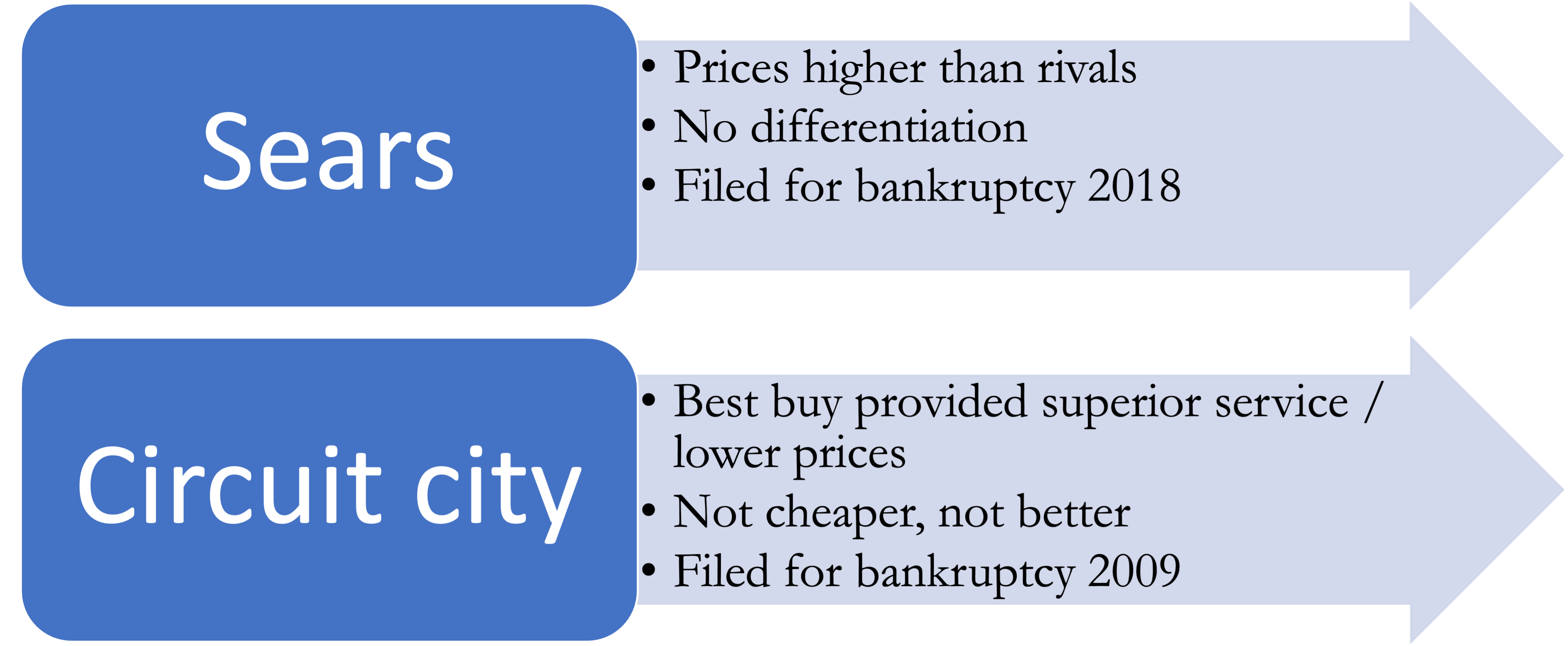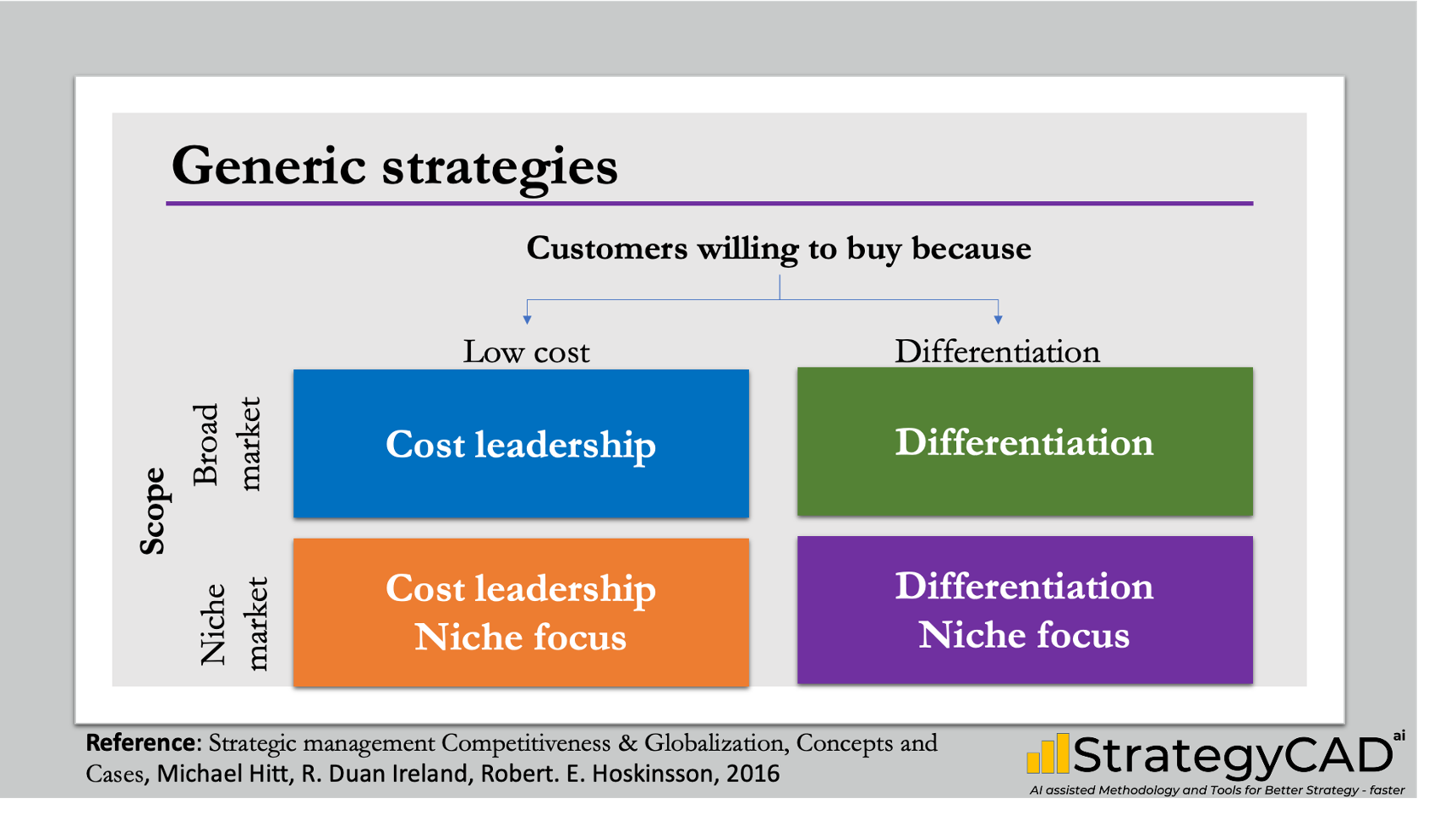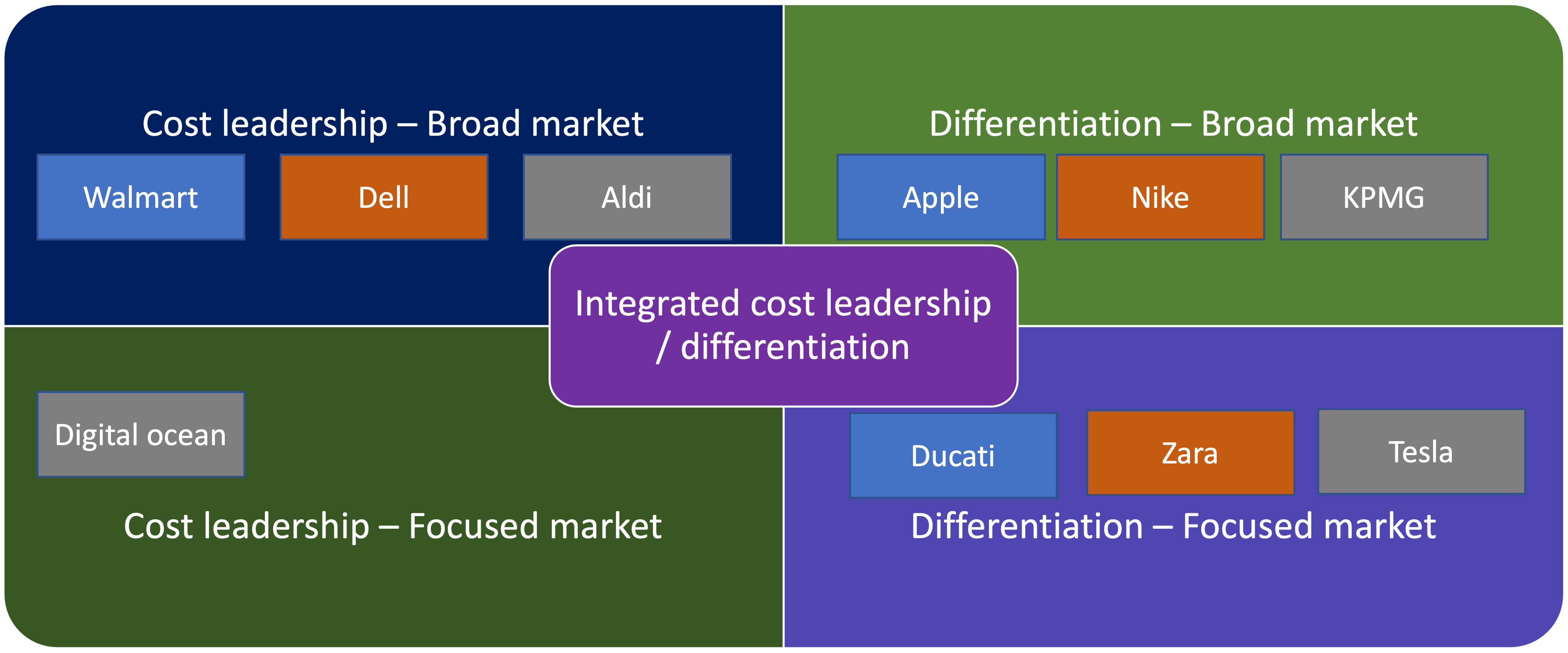The purpose of making strategic choices is to position your business
in a playing field of your choice, in way that your business succeeds.
That is it satisfies specific customers and
their needs in a way that other players cannot.
Using generic strategies can be a way to ensure faster and more
consistent choice making and subsequent refinement or
expansion of your strategic choices.
Michael Porter suggested that generic strategies can be defined by
two key dimensions: the scope of the strategy and the source
of the competitive advantage.
For scope, the company could target a broad market or a narrow focused market.
For the source of competitive advantage,
the company could either be the low-cost leader or a differentiator.
The result is these four quadrants that represent the four generic strategies:
Overall cost leadership, differentiation,
cost focus and differentiation focus.
Once you have identified whether your business aims to attract / win
customers either through a good enough product at a competitive price (Cost leadership)
or a Differentiated offering that meets specific customer needs in a way
that others do/can not, then making and validating your other strategic choices
will be easier to achieve consistently. Sometimes business leaders engineer
ambiguity by trying to be superior in some way, whilst also being
the cheapest which is difficult to do on a sustainable basis.
Generic strategies model
The following model shows the generic strategies model. It
is essentially a matrix that shows the ONLY two ways
a business generates a competitive advantage.
Source of competitive advantage
- Cost leadership
- Differentiation
Scope of the market
to be served
- Broad
- Focused
Read more:
There Are Still Only Two Ways to Compete links to Harvard Business Review
Differentiation strategy
Using differentiation as a source of advantage means the business
is focussed upon increased price for an offer superior
to some market segment as the main lever for financial
sustainability / competitive advantage.
This does not mean costs are irrelevant, but it does
mean the business is prepared to increase its costs to provide
a solution that is superior to some segment of the market.
The main risks with differentiation can include:
Higher costs with potential for limited appeal
Hence the ongoing investment in Research and Development capabilities
including early product to market fit validation.
Increased competition from imitators.
Hence the ongoing investment in Research, Development and
Innovation capabilities.
-
Change in customer preferences.
Hence the ongoing investment in external analysis and
customer research to
understand emerging customer needs and skating to where demand
is likely to be.
-
Limited appeal:
Hence the strategy will need to support investment in
Product management and Marketing capabilities.
Closing feedback loops between
these capabilities with Sales will also be frequently important.
-
Difficulty in differentiating:
A company that positions itself as a differentiator may
struggle to differentiate itself from its competitors / imitators
without a valuable resource inaccessible to competitors
e.g network effect, unique intellectual property or know-how.
Cost leadership
A cost leadership strategy is an integrated set of choices taken to produce
good or services that are acceptable to customers
at a low cost and potentially
the lowest cost relative to competitors. It does not mean the low-cost
leader does not have other quality differentiators
in its offering e.g. friendly service,
convenience, fast delivery etc. What it does mean the main competitive edge is its'
ability to deliver its offering to the market at the lowest cost.
Cost leadership is focussed on reducing costs through economies
of scale, minimize input and any / all unnecessary
activities related to production, distribution, marketing / sales
and so forth.
The main risks with cost leadership can include:
- Fixed costs: there is often
a substantial upfront investment in fixed costs (plant / machinery),
and given a downturn in demand, the business can start loosing money
very quickly.
Being out innovated, by a rival who develops a capability
to bring an equivalent offering or an
acceptable substitute offering at a lower price.
Low cost leaders scan the external and industry environment
for technology innovations that enable cost reductions e.g. process
automation, robotics etc.
-
Poor quality: In order to achieve low costs, a company may need to cut corners on things
like quality control or customer service.
This can lead to a decrease in the perceived value of the
company's products or services.
Low cost leaders frequently use an operational effeciency strategy
(described soon) to keep focus on quality.
-
Limited appeal:
A cost leadership strategy may not appeal to customers
who are willing to pay a higher price for higher-quality
products or services. This can limit the company's customer
base and make it more reliant on price-sensitive customers.
-
Difficulty in differentiating:
A company that positions itself as a low-cost leader may
struggle to differentiate itself from its competitors,
as price is typically the primary factor that customers
consider when choosing a low-cost product or service.
Failure to choose
Failure to be uniquely valuable to a market segment
either through differentiation or price can result in being stuck in the middle.
Stuck in the middle
A business is classified as stuck in the middle when
- Its product is not superior in any way to any segment
of an existing market i.e. it does satisfy any consumers needs
in a superior way AND;
- Consumers have ready access to cheaper alternatives

Examples

Overcoming being stuck in the middle
To overcome the challenges of being stuck in the middle,
a company may need to develop a more focused and
differentiated strategy.
This may involve identifying a unique value proposition or
niche in the market, investing in marketing and branding
efforts to better communicate the company's value to
customers, and/or seeking ways to improve efficiency and
reduce costs. It may also involve exploring new markets or
channels for growth, or partnering with other companies to
expand its reach and capabilities.
An additional way to classify your strategy
In addition to differentiation and cost leadership
there are 3 other ways to classify
your strategy. These can also be used
to make your strategic choices easier and
more consistent. These models come from the New Times Best selling book
The Discipline of Market Leaders: Choose Your Customers, Narrow Your Focus, Dominate Your Market
by Michael Treacy and Fred Wiersema.
These 3 models will seem obvious to you once presented, but then you
can choose to classify the type of strategy you want to create
based upon the differentiation / cost leadership along
with one of these.
Toyota is famous example of operational excellence
Operational excellence
There are several key elements of an
operational excellence strategy:
Continuous improvement:
This involves continuously reviewing and optimizing processes to identify and eliminate
waste and inefficiencies, and to improve quality and productivity.
-
Standardization: This involves establishing consistent, best-practice processes and
procedures across the organization to ensure efficiency and reduce variability.
-
Lean principles: These principles, which originated in the manufacturing industry,
focus on minimizing waste and maximizing value.
They can be applied to any type of operation to streamline processes and improve efficiency.
-
Six Sigma: This methodology uses data and statistical analysis to identify and eliminate defects
in processes, with the goal of improving quality and reducing variability.
Collaboration and empowerment: An operational excellence strategy often involves empowering
employees at all levels of the organization to identify and address inefficiencies and make
continuous improvement a part of the company culture.
Implementing an operational excellence strategy requires a commitment to ongoing process improvement
and a willingness to make changes to existing systems and practices.
It also requires the development of key performance indicators (KPIs) to measure progress and success.
-
Product leaders
Competitive advantage
obtained by creating
the best product / superior product for a market segment.
Customer
support and relationship management may not be best in class.
A product leadership strategy focuses on differentiation enabled by
understanding customer need (current / emerging), specialist
engineering and design capabilities, product management and continuous
innovation and adaptability.
-
Customer intimacy
Customer intimacy is an approach to creating competitive advantage
that focuses on differentiation through
building deep,
long-term relationships with customers by understanding their
needs, preferences, and behavior.
A customer intimacy strategy involves gathering and analyzing
customer data, engaging with customers on a regular basis,
and using that information to tailor products and services
to meet the specific needs of individual customers.
To implement a customer intimacy strategy,
a company develops a customer-centric culture
and may use a variety of tools and tactics,
such as customer surveys, focus groups, and customer
relationship management (CRM) systems focus on delivering a
personalized, high-quality customer experiences.
Your strategic thinking challenge
Strategic thinking
challenge for you and your strategy team















